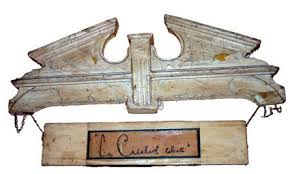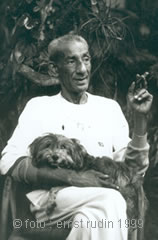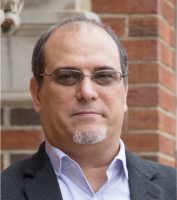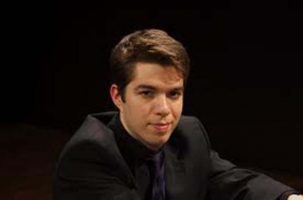
An illustrated presentation on the work of one of the most emblematic artists of Cuba’s counterculture, Juan Gualberto Ibáñez Gómez (Havana, 1933-2010), an artist, graphic designer, poet and writer, whose work constitutes one of the most adventurous and cutting-edge artistic incursions from the 1960s to the early 2000s on the island. He entered the art world as a member of Grupo Espacio, led by Cuban artist Loló Soldevilla (1901-1971). Between 1971 and 1976 his work was censored, and in 1978 decided to shut himself away from all cultural institutional life in his native country.
 Yonny (pictured left), as he was known to his fellow artists and friends, produced most of his work at home in Arroyo Apolo, southeast of Havana, sharing it only with closest friends and family. His first and only personal exhibition took place at the New Latin American Film Foundation in 1997 as part of the documentary En la ciudad celeste by Colombian journalist and filmmaker Luis Hernan Reina, dedicated to Yonny’s artwork and to his personal story as an artist.
Yonny (pictured left), as he was known to his fellow artists and friends, produced most of his work at home in Arroyo Apolo, southeast of Havana, sharing it only with closest friends and family. His first and only personal exhibition took place at the New Latin American Film Foundation in 1997 as part of the documentary En la ciudad celeste by Colombian journalist and filmmaker Luis Hernan Reina, dedicated to Yonny’s artwork and to his personal story as an artist.
At the moment of his passing, in 2010, Yonny’s work had started to enjoy local recognition by art critics and galleries. He was interviewed for several literary and cultural journals, including the publication of several of his poems.
This retrospective presentation, a decade after Yonny Ibánez’s death, will begin with a performance by pianist Edward Neeman of Juan Piñera‘s composition El libro de música de ‘La ciudad celeste’, followed by historian Jesús Jambrina‘s overview of the artist’s life and work, and capped by a contextual analysis by art scholar Mayté Acosta of the significance of Yonny’s work within the context of Cuban artistic tradition.
The presentation will be introduced by Perla Rozencvaig, Vice-President of the CCCNY, who will also moderate a bilingual Q&A via Zoom at the end.
This art and history event is part of the CreateNYC Language Access program, and it will be held in Spanish.
DUE TO THE COVID PANDEMIC, THIS EVENT WILL BE STREAMED THROUGH OUR YOUTUBE CHANNEL.
Please click on this link on the scheduled date and time:
https://youtu.be/ZBc0F3Er2t4
[Photo above: La ciudad celeste, de Yonny Ibáñez]
Jesús Jambrina, PhD, is Associate Professor of Spanish & Coordinator of Latin American Studies at Viterbo University,
Coordinator of Latin American Studies at Viterbo University,
La Crosse, WI. Among other books, he has published The Jews
of Zamora (2016), a historical account of Jewish presence
in northern Spain from the 10th to the 15th centuries.
He has written several articles on this topic, and
since 2013 he organizes an annual international conference
in Zamora to explore themes on Jewish history and culture in the northwest of the Iberian peninsula. In 2015, he received the Medal
of the Four Sephardic Synagogues granted by the Council of the Sephardic Community of Jerusalem, the oldest Jewish institution standing today in the land of Israel.
 Mayte Acosta is a doctoral student in the Art History program
Mayte Acosta is a doctoral student in the Art History program
at the University of Guanajuato, Mexico. Her specialization is
on Non-Western Art and its influence in Latin American Art,
a topic of which she has published peer reviewed articles,
and lectured at several institutions in Mexico and the
United States. She is currently teaching Advanced
Spanish Composition at Marconi University in Miami, Florida.
 of Australia and at the Music Conseratroy of Jakarta. He received his Ph.D. in music from The Julliard School, where he studied under Salomón Gadles Mikowsky, among others. He is the recipient of several awards, including the Joaquín Rodrigo in Madrid. He has played solo with several orchestras, including the Prague Philarmonic and the Sydney Symphonic Orchestra. In 2014 Neeman played Juan Piñera’s composition during the Segundo Encuentro de Jóvenes Pianistas at the San Francisco Basilica in Old Havana.
of Australia and at the Music Conseratroy of Jakarta. He received his Ph.D. in music from The Julliard School, where he studied under Salomón Gadles Mikowsky, among others. He is the recipient of several awards, including the Joaquín Rodrigo in Madrid. He has played solo with several orchestras, including the Prague Philarmonic and the Sydney Symphonic Orchestra. In 2014 Neeman played Juan Piñera’s composition during the Segundo Encuentro de Jóvenes Pianistas at the San Francisco Basilica in Old Havana.  Composer Juan Piñera teaches at the Instituto Superior de Arte en La Habana, where he graduated in 1972. He is the recipient of several awards, including recognitions at the 12th International Competition of Electroacoustic Music in Bourges, France, and at TRIMALCA, in Río de Janeiro. His trajectory as a composer includes works for piano, guitar, chorus, ballet, choreography, and incidental music for theater and cinema. His work El libro de música de ‘La ciudad celeste’ is inspired by the popular tertulias at the Gómez family’s home, Villa Manuelita, which he attended as a young man with his uncle Virgilio Piñera during the 70’s.
Composer Juan Piñera teaches at the Instituto Superior de Arte en La Habana, where he graduated in 1972. He is the recipient of several awards, including recognitions at the 12th International Competition of Electroacoustic Music in Bourges, France, and at TRIMALCA, in Río de Janeiro. His trajectory as a composer includes works for piano, guitar, chorus, ballet, choreography, and incidental music for theater and cinema. His work El libro de música de ‘La ciudad celeste’ is inspired by the popular tertulias at the Gómez family’s home, Villa Manuelita, which he attended as a young man with his uncle Virgilio Piñera during the 70’s.
This event is co-presented by the Latin American Studies Program at Viterbo University.

This presentation is supported, in part, by public funds from the New York City Department of Cultural Affairs in partnership with the City Council.
With the promotional collaboration of
